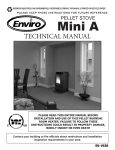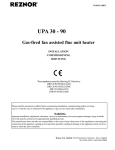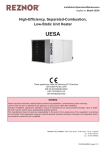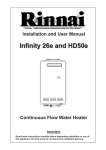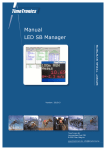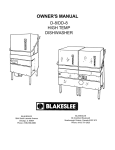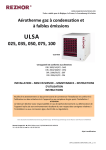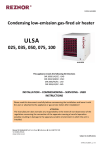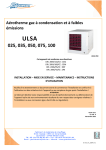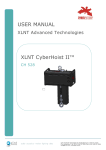Download Reznor UDSA 100-2 Technical data
Transcript
® 0803UDSA-2GBEN UDSA 008-2 / 100-2 Gas fired Balanced flue / Fan assisted flue unit heater INSTALLATION COMMISSIONING SERVICING These appliances meet the following EC Directives: DIR CE 90/396/EEG:GAD DIR CE 89/336/EEG:EMC DIR 73/23/EEG:LVD DIR 89/392/EEG:MD WARNING Please read this document carefully before commencing installation, commissioning and/or servicing. Leave it with the user or attached to the appliance or gas service meter after installation. Improper installation, adjustment, alteration, service or maintenance can cause property damage, injury or death. All work must be carried out by appropriately qualified persons. The manufacturer does not take any responsibility in the event of non-observance of the regulations concerning the connection of the apparatus causing an evil operation possibly resulting in damage to the apparatus and/or environment in which the unit is installed. Reznor U.K. Limited - Park Farm Road - Folkestone - Kent - England Tel.: 01303-259141 · Fax 01303-850002 0803UDSA-2GBEN, Pag. 1/36 INDEX Warnings ......................................................................................................................... 3 1. General...................................................................................................................... 4 2. Installation codes ...................................................................................................... 4 3. Warranty ................................................................................................................... 4 4. Uncrating and preparation ........................................................................................ 4 5. Dimensions ............................................................................................................... 5 6. Technical data ........................................................................................................... 7 7. Flueing requirements ................................................................................................ 8 8. Unit heater location .................................................................................................. 12 9. Hanging the unit ....................................................................................................... 13 10. Gas piping and pressures .......................................................................................... 15 11. Electrical supply and connections ............................................................................ 16 12. Check installation and start up.................................................................................. 18 13. Maintenance schedule ............................................................................................... 23 14. Heat exchanger maintenance .................................................................................... 24 15. Burner maintenance .................................................................................................. 25 16. Burner orifice ............................................................................................................ 27 17. Ignition system ......................................................................................................... 27 18. Fan motor .................................................................................................................. 28 19. Fan motor, fan blades and guard ............................................................................... 28 20. Venter motor and wheel ............................................................................................ 29 21. Gas valve .................................................................................................................. 31 22. Combustion air pressure switch ................................................................................ 32 23. Limit controls ........................................................................................................... 32 24. Flue and combustion air system ............................................................................... 33 25. Troubleshooting ........................................................................................................ 33 26. Parts list .................................................................................................................... 36 0803UDSA-2GBEN, Pag. 2/36 Warnings FOR YOUR SAFETY What to do if you smell gas: • Do not try to light any appliance. • Do not touch any electrical switch; do not use any phone in your building. • Immediately call your gas supplier. • Evacuate all personnel. FOR YOUR SAFETY Do not store or use petrol or other flammable vapours and liquids in the vicinity of this or any other appliance. WARNING: Improper installation, adjustment, alteration, service, or maintenance can cause property damage, injury, or death. Read the installation, operation, and maintenance instructions thoroughly before installing or servicing this equipment. WARNING : Gas-fired appliances are not designed for use in hazourdous atmospheres containing flammable vapors or combustible dust, in atmospheres containing chlorinated or halogenated hydrocarbons or in applications with airborne silicone substances. WARNING : Should overheating occur, or the gas supply fail to shut off, shut off the manual gas valve to the appliance before shutting off the electrical supply. WARNING : Do not use this appliance if any part has been immersed in water. Immediately call a qualified service technician to inspect the appliance and replace any gas control that hes been immersed in water. 0803UDSA-2GBEN, Pag. 3/36 1. General Models UDSA 008-2 through 100-2 are design certified to the CE EN1020 standard for use in industrial and commercial installations only. All models and sizes are available for use with either natural, propane or butane gas. The type of gas, the input rate and the electrical supply requirement is shown on the heater rating plate. Check the rating plate to determine if the heater is appropriate for the intended installation. This installation manual is shipped with the heater. Verify that the literature is correct for the heater being installed. If the manual is incorrect for the heater, contact the supplier before beginning installation. The instructions in this manual apply only to the models listed. Installation should be done by a suitably qualified installer in accordance with these instructions. The installer is responsible for the safe installation of the heater. 2. Installation codes These units must be installed in accordance with BS6230 or BS5440 as appropriate plus all local building codes. 3. Warranty Warranty is void if : a. Wiring is not in accordance with the diagram furnished with the heater. b. The unit is installed without proper clearances as soon as clearances are required regardless of the material being combustible. c. A fan model is connected to a duct system or if the air delivery system is modified. 4. Uncrating and preparation This unit was test operated and inspected at the factory prior to crating and was in proper operating condition. If the heater has incurred damage in shipment, document the damage with the transport company and contact your supplier. Check the rating plate for the gas and electrical specifications of the heater to be sure that they are compatible with the gas and electric supplies at the installation site. Read this booklet and become familiar with the installation requirements of your heater. If you do not have knowledge of local requirements, check with the gas supplier and any other local agencies who might have requirements concerning this installation. Before beginning, make preparations for necessary supplies, tools, and manpower. If the installation includes optional vertical louvers or downturn nozzle etc., install these options before the heater is suspended. Follow the instructions included in the option package. 0803UDSA-2GBEN, Pag. 4/36 5. Dimensions & Clearances (horizontal orientation=standard) Figure 1 Top view Rear view (all mod. except 035-2,0432,050-2) Front view Rear view ( only mod. 035-2,043-2,050-2) Side view Legend: 1. Combustion air inlet 2. Flue connection 3. External gas connection 4. Electrical connections 5. Service panel Table 1 : Dimensions (mm) T yp e 008 - 011 015 - 020 025 - 030 035 - 050 055 - 064 073 - 100 A 307 383 586 510 663 865 B 700 700 700 971 971 1040 C 267 343 546 456 609 812 D 404 404 404 601 601 651 E 696 723 771 1129 1138 1138 F 546 546 546 897 897 897 G 131 200 368 371 354 562 H 191 191 191 195 207 213 J 129 139 222 126 150 299 K 67 122 122 166 166 186 L 85 86 121 121 204 204 M 413 413 413 623 623 673 N 16 16 16 33 33 33 P 98 98 98 149 149 149 Q 350 350 350 600 600 600 R 120 120 140 140 225 225 0803UDSA-2GBEN, Pag. 5/36 Clearances (mm) Units must be installed so that the minimum clearances in the following table are provided for combustion air space, inspection and service and for proper spacing from combustible materials. Table 2 : Clearances (mm) Model X Y Z (*) U V 008-2 Æ 030-2 450 50 50 50 850 035-2 Æ 100-2 450 100 100 100 850 (*) : Heaters can be base mounted on suitable non combustible supports. Attention : The clearance distance from the flue system must be minimum 150mm at all points ! Combustion air supply and flue system diameters Diameter gas connection Table 3 : Model Ø flue/ air inlet (mm) Ø gas connection 008-2 011-2 015-2 020-2 025-2 030-2 035-2 043-2 050-2 055-2 064-2 073-2 085-2 100-2 80 80 80 80 100 100 100 100 100 130 130 130 130 130 1/2" 1/2" 1/2" 1/2" 1/2" 1/2" 3/4" 3/4" 3/4" 3/4" 3/4" 3/4" 3/4" 3/4" 0803UDSA-2GBEN, Pag. 6/36 6. Technical data Table 4 : Technical data TYP E S 008-2 Æ 030-2 Type 008-2 011-2 015-2 C omb. A ir & Flue, type B instal. 020-2 025-2 030-2 II2H3+ B22 Gas category 1 1 C 12, C 32, C 42, C52, C 62,C 82 C omb. A ir & Flue, type C instal.. Flue & combustion air connection collars mm 80 80 80 80 100 100 Heat input (Hs) Heat input (Hi) kW kW 8,8 7,9 13,2 11,9 17,6 15,9 22,0 19,8 30,8 27,8 35,2 31,7 Heat output Thermal efficiency Gas consumption rate kW % 7,3 92 11,0 92 14,6 92 18,2 92 25,5 92 29,2 92 nat. gas G20 prop. G31 m /h kg/h 3 0,84 0,62 1,26 0,93 1,68 1,24 2,10 1,55 2,94 2,16 3,36 2,47 K 32 32 32 32 32 32 m /h rpm m 3 680 1390 1020 1390 1360 1450 1700 1450 2385 930 2725 930 m dB(A) 8 47 Gas connection size (not supply line size) Temperature rise A irflow Motor speed 3 Recommanded mounting height 4 Horizontal air throw 5 S ound pressure E lectrical service (protection class IP2 0) Total electrical rating W eight (net) 2 1/2" TYP E S 03 5-2 Æ 10 0-2 T yp e 10 46 121 W kg 3,0 2,5 30 03 5-2 3,5 13 16 47 48 230/240V 1N ~ 50Hz 126 33 38 04 3-2 05 0-2 40 0 55 -2 20 50 22 51 273 56 60 0 64 -2 07 3-2 08 5-2 10 0 -2 13 0 10 2,7 9 2,5 8 5,1 92 13 0 11 7 ,3 10 5 ,7 9 7,0 92 II2H3+ G as cate go rie s C om b. A ir a nd Flue , typ e B insta l. 1 B 22 1 C om b. A ir a nd Flue , typ e C instal. F lue & co mb ustio n a ir connection colla rs He at input (Hs) He at input (Hi) He at o utp ut Therma l efficie ncy G as consump tio n mm kW kW kW % 1 00 42 ,2 38 ,0 34 ,9 92 1 00 50 ,8 45 ,8 42 ,1 92 C 12 , C 32 , C 4 2, C 52 , C 6 2,C 82 10 0 1 30 1 30 13 0 58 ,6 66 ,0 77 ,7 8 8,0 52 ,8 59 ,5 70 ,0 7 9,3 48 ,6 54 ,7 64 ,4 7 3,0 92 92 92 92 na t. g as G2 5 p ro p. G 31 m /h kg/h 3 4,02 2,96 4,85 3,57 5,59 4,12 6,3 0 4,6 4 7,4 1 5,4 6 8 ,39 6 ,18 9 ,79 7 ,21 11 ,1 8 8 ,24 K 3 m /h rp m 29 3 51 0 9 50 28 4 53 5 9 50 28 5 18 0 95 0 3/4 " 28 28 58 30 68 1 0 9 50 9 00 28 7 77 0 90 0 28 9 06 5 90 0 28 1 03 60 90 0 m m 25 28 30 d B (A ) 55 54 55 W kg 3 33 88 4 90 99 G as connection size (no t sup py line) Tem pe ra ture rise A irflow M oto r spe ed Re com m ende d m ounting he ight 4 Ho rizo nta l air thro w 3 5 S o und pressure E le ctrical se rvice (p ro te ction Tota l ele ctrical rating W e ight (net) 2 3 ,5 cla s s IP 2 0) 4 ,0 30 33 56 56 2 30 /24 0V 1N ~ 5 0Hz 49 0 4 90 6 78 99 1 12 1 18 35 36 39 58 59 59 84 8 14 3 84 8 15 8 84 8 16 8 1) Gas Appliance Classifications for Approved Venting Methods based on CEN-report CR1749:2001. 2) There is a difference between the gas connection diameter and the diameter of the supply line. Always use the most adequate dia of the supply line to minimize the pressue drop through the gas pipes - if necessary, reduce the diameter of the supply line at the inlet of the unit. 3) Height from floor to bottom surface of heater. These are recommendations only. Positioning of unit heaters for proper performance is application dependent. Operation is affected by other air moving equipment in the space, obstructions to the airflow, draughts and/or close proximity to doors or windows, etc ... Care should be taken to avoid mounting the heaters above these recommendations, unless downturn nozzle options are used, as significant stratification may occur resulting in poor floor coverage and higher energy losses through the roof structure. 4) Isothermal conditions +/-20°C ambient air temperature, discharge louvres zero deflection, v = 0,5m/s. The air throw will be influenced by the height of the building, mounting height of the unit, ambient temperature & adjustment of the louvres. 5) Sound pressure measured in dB(A) : at 5m distance of the heater with A=160m² & Q=2 0803UDSA-2GBEN, Pag. 7/36 7. Flue requirements Model UDSA-2 heaters may be installed as Type-B and Type-C installations. Flue must be in accordance with BS6230 or BS5440. Local requirements may apply in addition to national requirements. These unit heaters are designed to operate safely and efficiently with either a horizontal or vertical flue system when installed with the specific requirements and instructions. If this heater is replacing an existing heater, be sure that the flue is sized properly for the heater being installed and that the existing flue is in good condition. A properly sized flue system is required for safe operation of the heater. An improperly sized flue system can cause unsafe conditions and/or create condensation. The air heaters may be installed as a balanced flue (type C) heater requiring both a combustion air inlet duct and a flue pipe or as a power vented heater (type B) (the combustion air is taken from the space where heater is installed), which requires only a flue pipe exhausting to outdoors. All products of combustion must be flued to outdoor atmosphere. Each heater installed as a type B appliance must be fitted with an individual flue pipe and the combustion air inlet opening is provided with a protection grill. Each heater installed as a type C appliance must be fitted with an individual combustion air/flue pipe system. Type C2 appliance, with single duct system for supply of combustion air and evacuation of flue gasses, are not allowed. IMPORTANT : The flue must be installed in accordance with national and local regulations. Failure to provide proper flueing could result in death, serious injury and/or property damage. The air heater must be installed with a flue to the outside of the building. Safe operation of any power vented gas apparatus requires a properly operating flue system, correct provision for combustion air and regular maintenance and inspection. Diameter & maximum flue pipe lengths Flue pipe diameters and maximum pipe lengths in table 5 apply to both horizontal and vertical systems. Add all straight sections and equivalent lengths for elbow. The total combined length must not exceed the maximum flue length. Table 5 : maximum flue system pipe lengths Model UDS A Heater socket & pipe dia mm M ax. straight length (with wall/roof terminal) m Equivalent length of 45° elbow m Equivalent length of 90° elbow m • • flue pipe inlet pipe flue pipe inlet pipe flue pipe inlet pipe flue pipe inlet pipe 008-2Æ 020-2 025-2Æ050-2 055-2Æ100-2 80 80 9 9 0.75 0.75 1.5 1.5 100 100 9 9 0.75 0.75 1.5 1.5 130 130 9 9 0.75 0.75 1.5 1.5 Use only one diameter of flue pipe on an installation. Recommended minimum flue is 1m. 0803UDSA-2GBEN, Pag. 8/36 Flue outlet Venter outlet attachment requirements: Depending on the size of flue pipe as determined in table 5, attach either the flue pipe directly to the collar or a taper-type connector. WARNING : Single wall flue pipe exposed to cold air or run through unheated areas should be insulated to avoid condensation. Provision must be made for the condensation to flow freely to a point to which it can be released, i.e. a drain or gully. The condensation drain from the flue must be constructed from non-corrodible material not less than 20 mm diameter. Copper or copper based alloys must not be used for condensation drains. For testing, the flue pipe should include a sealable test port. Ideally the test port should be at least 450mm away from the air heater flue connection socket. However if a concentric flue fitting is attached directly to the connection sockets then the combustion should be tested through the flue outlet collar via a drilled test port which must be securely plugged on completion. Follow the flue pipe manufacturers installation instructions for making joints, including connections to the air heater, for passing through a building element and for support requirements. Gasket sealed single wall flue seamless aluminium or stainless steel pipes are required. All joints must be sealed to prevent products of combustion from leaking into the building. If the flue passes through a combustible element of the building it must be enclosed by a sleeve of non-combustible material and separated from the sleeve by a minimum of 25 mm air break. The temperature of any combustible material near to the flue must not exceed 65°C when the heater is in operation. The flue must be at least 150 mm away from any combustible material. Flues for power vented installations (type B appliances) If the air heater is to be installed as a type B appliance, air for combustion will be taken from within the space where the heater is installed. Ensure that an adequate air supply for combustion and ventilation is provided within the building in accordance with BS6230/BS5440 plus other relevant regulations & rules in force. Figure 2 : Approved appliances type B B22 - roof B22 - wall 0803UDSA-2GBEN, Pag. 9/36 Figure 3 : Type B appliances : Combustion air and flue pipe sockets all mod., except. 035-2,043-2, 050-2 only mod. 035-2, 043-2 & 050-2 1) Flue pipe outlet collar 2) Combustion air inlet opening Air supply WARNING : When these air heaters are installed in type B applications, designed to take air for combustion from the space in which it is installed. Do not restrict the combustion air intake. It is important to ensure that there is an adequate air supply at all times for both combustion and heating requirements. Modern buildings involve greater use of insulation, improved vapour barriers, and weather proofing. These practices mean that buildings are sealed much tighter than in the past. Proper combustion air supply for a power vented Type B installation requires ventilation of the heated space. Natural infiltration of air may not be adequate. Use of exhaust fans aggravates this situation. It is important to ensure that there is adequate combustion air supply at all times. Reliance on doors and windows is not allowed. Always ensure that adequate combustion air is provided to suit the total installation of all combustion equipment in accordance with BS6230 or BS5440 as appropriate. Ensure that the air combustion inlet opening at the rear side of the unit cannot be obstructed (cfr. fig. 3). 0803UDSA-2GBEN, Pag. 10/36 Combustion air inlet pipe & flue pipe for balanced flue installation (type C appliances) Balanced flue air heaters are designed to be fitted with a combustion air inlet duct that obtains outdoor air and a flue pipe that exhausts flue products to outdoors. Both the flue and combustion air pipes must be sealed. Type C2 appliances must not be applied ! Figure 4 : Approved appliances type C C12 C32 / C62 C12b/C62 C52 Figure 5 : Type C appliances : Combustion air and flue pipe sockets all mod. except. 035-2, 043-2 & 050-2 only mod. 035-2, 043-2, 050-2 1) Flue pipe outlet collar 2) Combustion air pipe inlet collar 0803UDSA-2GBEN, Pag. 11/36 8. Location heater Remark: Flue requirements may affect location. Consult section 7 before making a final determination. Use the minimum clearances in section 5 and the throw data in the technical data table of section 6 when determining where to suspend the heater. Recommended minimum height is 2.5mm. WARNING: If touched, the vent pipe and internal heater surfaces that are accessible from outside the heater will cause burns. Suspend the heater such that these components cannot be touched. For best results, the heater should be placed with certain rules in mind. Always ensure that minimum clearances are maintained. Locating a unit heater above the maximum recommended height can result in significant air stratification. When possible, heaters should be arranged to blow toward or along exposed wall surfaces. Suspended heaters are most effective when located as close to the working zone as possible, but care should be exercised to avoid directing the discharged air directly on to room occupants. Partitions, columns, counters, or other obstructions should be taken into consideration when locating the unit heater so that a minimum quantity of airflow will be deflected by such obstacles. When units are located in the centre of the space to be heated, the air should be discharged toward the exposed walls. In large areas, units should be located to discharge air along exposed walls with extra units provided to discharge air in toward the centre of the area. For optimum results heaters are best used in conjunction with recirculating air fans suspended at high level. At those points where infiltration of cold air is excessive, such as at entrance doors and shipping doors, it is desirable to locate the unit so that it will discharge directly toward the source of cold air, typically from a distance of 4.5 to 6.0 meters or install a downflow unit over the door opening. CAUTION : Do not locate the heater where it may be exposed to water. Hazards of Chlorine apply to the location of the combustion air inlet The presence of chlorine vapours in the combustion air of gas-fired heating equipment presents a potential corrosion hazard. Chlorine, found usually in the form of freon or degreaser compounds when exposed to a flame will precipitate from the compound, and go into solution with any condensation that is present in the heat exchanger or associated parts. The result is hydrochloric acid which readily attacks all metals. Care should be taken to separate these vapours from the combustion process. This may be done by wise location of the unit flue and combustion air terminals with regard to exhausters or prevailing wind directions. Chlorine is heavier than air. Keep this fact in mind when determining installation location of the heater in relation to building exhaust systems. Where chlorine vapours are prevalent heaters with special grade 316 A1SI stainless steel heat exchangers are recommended. 0803UDSA-2GBEN, Pag. 12/36 9. Hanging the heater WARNING: Check the supporting structure to verify that it has sufficient loadcarrying capacity to support the unit weight. Suspend the heater only from the threaded nut retainers or with a manufacturer provided kit. DO NOT suspend from the heater cabinet panels. . Before suspending the heater, check the supporting structure to verify that it has sufficient load-carrying capacity to support the weight of the unit. Leave the unit on the pallet. If the bottom of the unit is not supported or protected damage can occur. Table 6 : weights (kg) Size 008-2 011-2 015-2 020-2 025-2 030-2 035-2 043-2 050-2 055-2 064-2 073-2 085-2 100-2 kg 30 33 38 40 56 60 88 99 99 112 118 143 158 168 Warning : Do not place or add additional weight to the suspended heater. The heater is supplied with four point suspension. All points must be used. Two threaded nut retainers are provided on each side of the top of the heater. See figure 6 for hanger rod size. Figure 6 : Suspending the heater with rods from the threaded nut retainers Add a nut to lock the M10x1.5 hanger rod to the heater Detail Be sure that the threaded hanger rods are locked to the heater as illustrated in figure 6. Recommended maximum hanger rod length is 1.8m. Where longer drops are required, ensure that restraints are fitted to prevent excess lateral movement and supports are adequately sized. 0803UDSA-2GBEN, Pag. 13/36 Figure 7 : Wall bracket kits (optional) When desired the heaters may be supported by wall brackets. Supporting in this manner allows the heaters to be placed in close proximity to the ceiling or mounted directly to the vertical supporting structures of the building. There are 2 different wall bracket designs for UDSA-2 models as shown in the illustrations below. Mounting instructions are detailed in the literature supplied with these optional kits Types 008-2 -> 030-2 Types 035-2 -> 100-2 0803UDSA-2GBEN, Pag. 14/36 10. Gas Piping and pressures WARNING: All components of a gas supply system must be leak tested prior to placing equipment in service. NEVER TEST FOR LEAKS WITH AN OPEN FLAME. Failure to comply could result in personal injury, property damage or death. Warning : This appliance is equipped for a maximum gas supply pressure of 50 mbar. WARNING : Pressure testing supply piping Test pressures above 50mbar : Disconnect the heater and manual valve from the gas supply line which is to be tested. Cap or plug the supply line. Test pressures below 50mbar : Before testing, close the manual valve on the heater. All piping must be in accordance with requirements outlined in the National Gas Codes (different for each country). Gas supply piping installation should also conform with good practice and any local codes. Support gas piping with pipe hangers, metal strapping, or other suitable material. Do not rely on the heater to support the gas pipe. All sealing products shall be resistant to the action of liquefied petroleum gas or any other chemical constituents of the gas being supplied. Install a ground joint union and manual shutoff the gas cock upstream of the unit control system. The unit is equipped with a nipple that extends outside the cabinet. The gas connection is 1/2” or 3/4”, dependent on the size of the unit. Leak test all connections by brushing on a leak detecting solution. Diameter gas connection Table 7 : Nat gas Propane Model 008-2 through 030-2 Model 035-2 through 100-2 WARNING : Do not o ver tighten and ov do not rrota ota te the g as otate gas valv e inside the hea ter alve heater contr ol compar tment. control compartment. 1/2” 3/4” Figure 8 : gas connection 0803UDSA-2GBEN, Pag. 15/36 11. Electrical supply and connections DANGER : THIS APPLIANCE MUST BE EARTHED. The electrical installation may only be carried out by an appropriately qualified person current to IEE Regulations. The supply line to the heater should include a main switch. The minimum clearance distance between the contacts must be more than 3 mm. All electrical connections should be made in the heater control compartment (refer to figure 9). Screw type terminals are provided. Connections should be in accordance with the terminal markings and the wiring diagram affixed to the air heater. Attention : Serious damage can occur to burner relay when faulty connection of thermostat, reset switch or burner failure lamp. Switching of wires for reset switch and flame failure (e.g. in a remote control box) will destroy the burner relay. The minimum external control required for the air heater is a room thermostat. It is essential that the main input line and neutral to terminals L and N remain live at all times even when the heater is switched off to ensure correct operation of the unit. A burner reset switch with red indicator light is fitted on the heater. To add a remote reset button, make connections to the terminals in the electric box as indicated on the wiring diagram. IMPORTANT: If the reset button requires activating for any reason, the cause must be determined. After determining and correcting the problem, restart the heater and monitor long enough to ensure proper operation (approx. 5 minutes). An orange indicator light is fitted on the heater to signify when the burner is on. Ensure that all cables and installers wiring are fixed to the gas pipe and that they do not touch the combustion collector box. Thermostat location Do not attempt to control more than 1 air heater from a single thermostat or control panel unless a properly wired relay is fitted. Follow the instructions supplied with such panels. The location of the room thermostat or sensor is very important. It should not be positioned on a cold wall or cold surface. Avoid location in draughty areas or where it may be influenced by heat sources e.g. the sun, process plant, etc. The thermostat should be mounted on a vibration free surface and mounted about 1,5 metres above floor level. Follow the thermostat manufacturers instructions. The thermostat must be suitable for potential free contacts. 0803UDSA-2GBEN, Pag. 16/36 Figure 9 : Wiring connections on the terminal board 0803UDSA-2GBEN, Pag. 17/36 12. Check installation & start-up Check the installation prior to start-up Check suspension. Unit must be secure.Verify that no other parts are fitted which are not individually supported and secured. Check clearances from combustibles. Requirements are in section 5. Check vent system to be sure that it is installed according to the instructions in section 7, venting requirements. Check piping for leaks and proper gas line pressure. Bleed gas lines of trapped air. Check electrical wiring and ensure that wiring conforms with the wiring diagram. Be sure all wire sizes meet requirements. Check polarity. Verify that line voltage exists between the black “L1” and earth ground. Verify that the appliance is earthed by conducting an earth continuity test. Heater start-up WARNING: For your safety, follow the instructions exactly otherwise damage or injury could occur. • This heater does not have a pilot flame. It is equipped with an ignition device which automatically lights the burner. Do not try to light the burner by hand. • Before operating, smell all around the heater area for gas. Be sure to smell next to the floor because propane gas is heavier than air and will settle near the floor. • Do not use this appliance if any part has subjected to water ingress. Immediately call a qualified service technician to inspect the appliance and to replace any part of the control system and any gas control. • When overheating occurs or when gas supply is not turned off, shut the manual gas tap before turning off the electric power. 0803UDSA-2GBEN, Pag. 18/36 Operating instructions and operating sequence 1. Set thermostat to the lowest setting. 2. Turn off all electric power to the heater. 3. Shut the gas cock at the inlet of the unit. 4. Wait five (5) minutes to clear out any gas. Then smell for gas, including near the floor. If you smell gas, STOP! and follow the steps in the WARNINGS printed on page 3. If you do not smell gas, proceed to the next step. 5. 6. Turn on the electric power to the heater. Open the gas cock at the inlet of the unit. 7. If fitted, ensure that a time switch is set to an ‘ON’ period. 8. Adjust the thermostat to the required setting (must be above current room temperature). Note : If the appliance does not operate, follow the instructions "To turn off gas supply at the Appliance" printed below and call your service technician. 9. Thermostat calls for heat, energyzing the venter motor. 10. When adequate air flow for combustion is proven by an air proving switch and a prepurge period has elapsed, the integral ignitor and multifunctional gas control operate. The ignition spark ignites the gas creating the burner flame. 11. Burner flame is sensed by a flame rod sensor and when the heat exchanger is warmed up (+/- 30 seconds) and the fan control relay closes, the fan motor is energized. 12. If the flame is extinguished during the main burner operation, the integrated control system closes the main valve and attempts to relight the burner. The unit will attempt 5 ignitions before entering a “lock out” mode. Lock out is indicated by the red warning light on the heater. To end this mode push on the reset switch. 13. To turn the heater ‘OFF’ for short periods : adjust the room thermostat to its lowest setting or ‘OFF’. The fan will continue to run to cool the heater and then switch off automatically. 14. To turn the heater ‘OFF’ for long periods : see ‘To turn off gas supply at the appliance’ below. Check installation after start-up TO TURN OFF GAS SUPPLY AT THE APPLIANCE 1) Set thermostat to the lowest possible setting or ‘OFF’ position. 2) Shut off the gas tap when the fan has stopped. 3) Switch off electric power to the appliance. Check gas pressure as described in detail below. Turn the unit off and on, pausing 2 minutes between each cycle. Observe for smooth ignition. Set the thermostat to the required room temperature. Place this booklet and any control or optional information in an accessible location near the heater or give this information to the end user. 0803UDSA-2GBEN, Pag. 19/36 Burner gas pressure adjustment The gas pressure is set for the required heat input before the appliance leaves the factory. Provided that the gas supply to the air heater is in accordance with the supply pressure described on the appliance data plate, the operating pressure will not require adjustment. To check the pressure use the following procedure: * Ascertain from the heater’s data plate the correct operating gas pressure; * Turn the room thermostat control to its lowest setting; * Remove the screw from the burner pressure test point of the multi-functional control valve. Connect a manometer to the test point( see figure 10a & 10b); * Adjust the room thermostat to call for heat i.e. above room ambient temperature; * Observe the burner gas pressure on the manometer and compare to the required pressure on the data plate; * If necessary, adjust the burner gas pressure. Remove the cover screw (models 035-2 - >100-2) or cover cap (models 008-2 -> 030-2). Turn the regulator screw anti-clockwise to decrease pressure or clockwise to increase pressure (see figure 10a & 10b); * Set room thermostat to lowest setting to turn OFF the burners. Replace the test point screw/cap and with the main burner OFF, test for gas soundness using a leak detector fluid. Reset temperature control/room thermostat to comfort operating level. Figure 10a : Honeywell gas valve (types 008-2 -> 030-2) 1 5 2 3 4 6 8 7 7 Legend: 1) Shut-off solenoid valve EV1 2) Pressure regulator setting device, or, alternatively, outlet flow setting screw 3) Inlet pressure test point 4) Outlet pressure test point 5) Shut-off solenoid valve EV2 6) Pilot outlet 7) Main gas outlet 8) Holes (M5) for fixing flanges 0803UDSA-2GBEN, Pag. 20/36 Figure 10b : HONEYWELL gas valve (type 035-2 -> 100-2) 6 8 7 5 1 3 2 4 Legend 1) Gas inlet 2) Gas outlet 3) Inlet pressure tap 4) Outlet pressure tap 5) 6.3mm AMP terminals and screws for wiring 6) 6.3mm AMP terminals 7) Earth terminal/screw (line voltage models only) 8) Pressure regulator adjustment screw Table 8 : Burner jets and pressures 008-2 011-2 015-2 020-2 025-2 030-2 035-2 043-2 050-2 055-2 064-2 073-2 085-2 100-2 Nat. Gas (G20) Prop. (G31) Burner jet Burner pre ssure Burner jet Burner pre ssure dia 2,60 3,20 3,70 4,20 4,80 5,30 5,75 6,50 6,80 7,10 8,00 mbar 8,00 7,90 7,80 7,10 8,20 7,50 7,90 7,10 7,90 8,40 7,90 12,00 8,00 7,10 1,70 1,95 2,15 2,60 2,80 3,10 3,35 3,70 3,90 4,15 5,20 dia 1,40 7,40 4,50 8,90 10,00 4,90 mbar 36,90 36,90 36,90 36,90 36,80 36,80 36,00 35,90 35,80 35,70 35,60 35,10 34,60 34,50 inlet pressure 20mbar inlet pressure 37 mbar Minimum inlet pressure natural gas G20 : 16,6mbar Minimum inlet pressure propane gas G31 : 35,2mbar 0803UDSA-2GBEN, Pag. 21/36 Ignition system Normal Heat Cycle Operating Sequence This heater is equipped with a direct spark integrated control relay. The control relay monitors the safety devices and controls the operation of the venter motor and the gas valve between heat cycles. The time line below illustrates a normal heat cycle. Power to gas valve and ignitor Start pre-purge Sensor checks for the presence of a flame Energisation of venter motor. If the differential pressure switch is in normally closed position (start position). End of heat demand. De-energisation of gas valve. De-energisation of venter motor Start position Pre-purge time Ignition time= Safety time 20 sec 5 sec Normal operation of burner relay Post-purge time 10 sec time First heat demand signal. Check on pressure switch. Must be in closed or start position. If not, there will be no power to the venter motor. The power to the burner relay is off until the pressure switch goes to normally closed - or start position. Safety check on flame sensor. If there is a flame, the relay will go to lock-out. The light in the red reset switch, mounted visibly on the heater will glow. If no flame, then repeat starting at pre-purge for 5 attempts. If no ionisation after 5 attempts, then lock-out. Line output during ignition time to control high fire start on two stage or modulation applications. Definitions Start position: The system is not in lock-out position and can proceed with the start-up sequence upon a demand for heat. Pre-purge time:This is a period of 20 seconds during which the combustion fan (venter) operates prior to activation of the ignition device. Safety time: The safety time is the delay between the gas valve being energised and the flame sensor checking for the presence of a flame. This is a period of 5 seconds. Note: If no flame is sensed, the burner relay will attempt ignition 5 times before going into lock-out mode. Post-purge time: This is the time of 10 seconds between burner shut-down and the moment the combustion fan (venter) is de-energized. 0803UDSA-2GBEN, Pag. 22/36 13. Maintenance & Service Warning : If you turn off the power supply, always turn off the gas. The material contained in the MAINTENANCE AND SERVICE Section of this manual is designed to aid a qualified service technician in maintaining and servicing this equipment. This heater will operate with a minimum of maintenance. To ensure long life and satisfactory performance, a heater that is operated under normal conditions should be inspected and cleaned at the start of each heating season (inspection and maintenance at least once a year). If the heater is operating in an area where an unusual amount of dust or other impurities are present in the air, more frequent maintenance is recommended. When any service is completed, be careful to reassemble correctly to ensure that no unsafe conditions are created. When starting the heater, always follow the lighting instructions on the heater. Maintenance Schedule - The following procedures should be carried out at least once each year (See figure 11a) : Maintentance Schedule • Clean all dirt, lint, and grease from the fan blade, fan guard, and motor. • Check the heat exchanger both internally and externally for evidence of physical damage. NOTE: If replacement parts are required, use only factory-authorized parts. • Check the burner for scale, dust, or lint accumulation. Clean if required. • Check the vent or vent/combustion air system for soundness. Replace any parts that do not appear sound. • Check the wiring for any damage. Replace damaged wiring. Figure 11a-Location of controls 12 11 2 10 8 Legend: 1) Burner 2) LC3 limit control 3) Burner operating light (H6) 4) Reset switch (S3) 5) Spark ignitor (ER) 6) Control panel assy (fig. 11b) 7) Gas valve (V1) 8) Fan motor (M1) 9) Venter motor. Venter motor is in the same location for all models, but appearance may differ (M3) 10) Fan control (FC) 11) Limit control LC1 12) Flame sensor (IS) 13) Reset LC3 (limit control) Sensor bulb is located in the air outlet of the heater. 14) Fuse (F3.1) 4 3 1 5 7 13 14 6 0803UDSA-2GBEN, Pag. 23/36 9 Figure 11b - Control panel assy located on a removable bracket 15 17 18 Legend: 15) Control relay (ER) 16) Terminal blocks 17) 2 stage burner relay K1.2 (option) (not illustrated) 18) Relay (K1.6) 19) Connector 20) Filter 21) Pressure switch (S3) 22) Electronic burner relay fuse 21 22 19 14. Heat exchanger Maintenance 16 20 This heater is equipped with a patented T-CORE2® heat exchanger. Remove any external dirt or dust accumulation. Visually check the heat exchanger for cracks and holes. If a crack or hole is observed, replace the heat exchanger. 0803UDSA-2GBEN, Pag. 24/36 15. Burner Maintenance Burner removal 2 This heater has a unique one-piece T-CORE ® burner assembly designed to provide controlled flame stability without lifting or flashback. The burner can be removed as a unit for inspection or service : see below for removal instructions. Inspect the burner/control compartment annually to determine if cleaning is necessary. If there is an accumulation of dirt, dust, and/or lint, clean the compartment and follow the instructions below to remove and clean the burner. Caution : use of eye protection is recommended. Instructions for burner removal (see fig. 11a) 1. Outside the cabinet, shut the gas supply off at the manual valve ahead of the union 2. Turn off the electric supply. 3. Disconnect the gas supply at the union outside of the cabinet. 4. Open the access door. 5. Disconnect the manifold and move it out of the way. At the gas valve, mark and disconnect the connector. Carefully remove the burner orifice and orifice adapter locking nut. Slide the orifice adapter out through the bracket on the burner pushing the manifold to the right. This will move the manifold out of the way. Refer to figure 14 for component definitions. Figure 12a Figure 12b Burner orifice Locking nut Orifice adapter 0803UDSA-2GBEN, Pag. 25/36 6. Remove burner a) Locate the burner body front support. Remove the screws that attach it to the secondary air shield. Refer to fig. 14 for component definitions. Figure 13a b) Holding the venturi tube, slide the entire burner slightly to the right to disengage the burner from the supports on the left. Then rotate the open end of the venturi tube outward away from the heater. Carefully pull the burner assembly out of the cabinet. Figure 13b Figure 14 - Burner removal steps 2. Remove screws attaching burner 3. Venturi tube : slide right, rotate outward, pull out 1. Disconnect manifold at orifice and outside the heater, slide to the right 0803UDSA-2GBEN, Pag. 26/36 Inspect and clean the burner With the burner assembly removed, shine a flashlight on the burner ribbons. Look for carbon buildup, scale, dust, lint, and/or anything that might restrict flow through the spaces between the burner ribbons. Holding the burner assembly so that any foreign material will fall away from the burner, use a stiff bristle brush to loosen Figure 15 and remove any foreign material(s). If the burner is excessively dirty, remove one of the burner end caps. Remove the four screws that hold the end cap to the burner housing. Lightly tap the end cap to remove it. Clean all foreign material from the burner and venturi. After the burner is thoroughly clean, replace the end cap making certain that it is tight against the burner housing. NOTE: If any of the burner components are damaged or deteriorated, replace the burner assembly. Inspect the Internal Portion of the Heat Exchanger (with burner assembly removed) At the burner flame entrance of each tube, shine a bright light into each heat exchanger section. With the light shining into the heat exchanger, observe the outside surface of the tube where discoloration is evident. Repeat this procedure with each heat exchanger tube. If any light is observed in these high temperature regions, replace the heat exchanger. Reinstall the burner Repeat ‘Burner removal’ steps above in the opposite order. 16. Burner orifice The burner orifice normally needs to be replaced only when a change in gas is made. When ordering a replacement orifice, provide (MJ/m3) heating value and specific gravity of gas, as well as the model and serial number of the unit. When removing or replacing the burner orifice be careful not to damage the venturi tube and/or the bracket. 17. Ignition system Ignitor - Refer to figure 11a and locate the ignitor. Disconnect the wire; remove the screw and the ignitor. Clean the ignitor assembly with an emery cloth. Spark gap must be maintained to 3 mm. See FIGURE 16a. Important : When reassembling, the wire must remain attached to the ignitor. 0803UDSA-2GBEN, Pag. 27/36 Figure 16a Ignitor showing required spark gap measurement Figure 16b Flame sensor Caution : Due to high voltage on the spark wire and electrode, do not touch when energized. Flame sensor - Refer to figure 11a and locate the flame sensor. Disconnect the wire, remove the screw and the flame sensor. Clean with an emery cloth.. Control relay - See figure 17. The electronic burner relay monitors the operation of the heater including ignition. Do not open the control relay. Each heating season check the lead wires for insulation deterioration and good connections. Proper operation of the direct spark ignition system requires a minimum flame signal of 1.0 microamps (DC) as measured by a microammeter. For further information and check out procedure on the direct spark ignition system, refer to section 12 and the Troubleshooting Flow Chart in section 25. Figure 17 - Control relay Fuse 18. Fan motors 19. Fan motor, Fan blades & Guard The fan motor is equipped with thermal overload protection of the automatic reset type. Should the motor fail to run, it may be because of improper voltage characteristics. Make certain that the correct voltage is available at the motor. Remove dirt and grease from the motor, the fan guard, and blades. Use care when cleaning the fan blades to prevent causing misalignment or imbalance. Check that the hub of the fan blades is secure to the shaft. Follow these instructions for replacement of the fan guard, fan motor and/or fan blades. 1. If the heater is installed, turn off the gas and disconnect the electric power. 2. Open the access door and disconnect the fan motor wires. 0803UDSA-2GBEN, Pag. 28/36 Figure 18 - Fan blade position on the motor shaft 3. Remove the fan assembly (fan guard, motor and fan blade). 4. Disassemble and replace parts as needed, then reassemble. Be sure the fan blade is in the proper position on the shaft; refer to the illustration and table in figure 18. Table 9 : Dimensions A S ize 008 011 015 020 mm 29 23 50 49 Fan ventilatormotor motor Fan blade ventilatorwiel 20. Venter motor & wheel 025 83 030 80 035 80 043 87 050 87 055 91 064 95 073 89 085 86 100 89 Position the assembly on the heater and attach the fan guard. Rotate the fan blade by hand to check for adequate clearance. If adjustment is required, loosen the mounting screws, reposition the fan guard, and tighten the screws. Rotate the fan blade and recheck for adequate clearance. Repeat this procedure until the assembly is positioned properly. 5. Reconnect the fan motor wires according to the wiring diagram and close the access door. 6. Restore power to the heater and turn on the gas. Light, following the instructions on the lighting instruction plate. Check for proper operation. Remove dirt and grease from the motor casing, the venter housing, and the venter wheel. Venter motor bearings are permanently lubricated. Follow these instructions for replacement of the venter motor and wheel assembly. Keep all hardware removed to be used in reassembling and installing the replacement parts. 1. Turn off the gas and disconnect the electric power. 2. Open the control compartment access door. 3. Disconnect the three venter motor wires at the control relay and ground screw (located on the control panel). 4. Holding the motor, remove the screws that attach the motor plate to the venter housing. Remove the motor and wheel assembly from the heater. 5. Reassemble with the replacement venter motor and wheel assembly. 6. Follow the wiring diagram to properly connect the wires. 7. Restore power to the heater and turn on the gas. Light, following the instructions on the lighting instruction plate. Check for proper operation. Replace the access door. binnenmaat 0803UDSA-2GBEN, Pag. 29/36 Venter wheel position on shaft UDSA models 008-2 - 020-2 (Rotation clockwise from motor shaft end) Figure 19 Venter motor plate Motor mounting bracket Venter wheel Motor cooling fan 8 mm 8 UDSA models 025-2 - 030-2 (Rotation clockwise from motor shaft end) Figure 20 Venter wheel Venter motor plate Motor mounting bracket Motor cooling fan 8 mm 0803UDSA-2GBEN, Pag. 30/36 UDSA models 035-2 - 100-2 (Rotation counter clockwise from motor shaft end) Figure 21 Venter motor plate Motor mounting bracket Venter wheel Motor cooling fan 8mm 8 mm 21. Operating gas valve WARNING: The operating valve is the prime safety shutoff. All gas supply lines must be free of dirt or scale before connecting to the unit to ensure correct sealing. The main operating quick opening gas valve is powered through the thermostat and safety controls. The main control valve is of the diaphragm type providing regulated gas flow and is preset at the factory. The gas valve requires no field binnenmaat maintenance except careful removal of external dirt accumulation and checking of wiring connections. Instructions for testing pressure settings are in section 12. Figure 22 Figure 23 Gas valve (UDSA models 008-2 - 030-2) Gas valve (UDSA models 035-2 - 100-2) 0803UDSA-2GBEN, Pag. 31/36 22. Combustion air pressure switch DANGER : Safe operation of this unit requires proper venting flow. Never bypass the combustion air pressure swtich or attempt to operate the unit without the venter operating. 23. Limit controls If a limit control needs replacing, use only the factory authorized replacement part for the size of heater. For approximate limit locations, see figure 11a.. The combustion air pressure switch ensures that proper combustion airflow is available. The switch senses the differential pressure between the negative pressure in the flue gas collector box and the pressure in the control section. (For switch location, see figure 11b). On startup when the heater is cold, the sensing pressure is at the most negative level, and as the heater and flue system warm up, the sensing pressure becomes less negative. If a restriction or excessive flue pipe length causes the sensing pressure to be below the allowable level, the pressure switch will shut off the main burner. Figure 24 See figure 10, for location. If it is determined that the pressure switch needs replacing, use only the factory-authorized replacement part that is designed for the model and size of heater being serviced. All units are equipped with temperature activated limit controls. The controls are factory set and non-adjustable. If either setpoint is reached, the corresponding limit control will interrupt the electric power to the gas valve. These safety devices provide protection in the case of motor failure or lack of airflow due to restrictions. (For locations, see figure 11a.) Figure 25 : LC1 Figure 26 : LC3 Warning : Never bypass the limit controls, hazardous conditions could result. Figure 27 : Fan control (KFC) 0803UDSA-2GBEN, Pag. 32/36 24. Flue and combustion air piping Check the complete system at least once a year. Inspection should include all joints, seams, concentric adapters and the flue terminal cap. Replace any defective or heavily corroded parts. 25. Troubleshooting The integrated control relay monitors the operation of the heater. If the heater fails to operate properly, review the flow chart below and see the operating sequence in section 16. The general troubleshooting charts on the following pages will also help you to determine the problem. Control relay Troubleshooting flowchart Trial for ignition Call for heat Is there a spark across gap at igniter? NO YES Is there line voltage at spark igniter? NO Check connection at spark igniter Replace igniter Is there line voltage to the control relay? YES Replace control relay NO Check wiring connections 0803UDSA-2GBEN, Pag. 33/36 Trial for ignition Call for heat Is there a spark across gap at igniter? YES Does gas ignite? YES Is there m in. flame current at the flam e sensor? YES NO Is there m in. flame current at the control m odule? Is the flame s ensor corroded? NO YES Check connections to flame sensor and/or m oisture in the burner assem bly Clean flame sensor with emery cloth or s teel wool YES NO Replace control module Is the sensor located in flam e? Is the heater grounded (earthed)? YES NO Repos ition flame sensor Trial for ignition Call for heat Is there a spark across gap at igniter? YES YES Replace flame s ensor NO Connect ground wire (earth) to unit chassis Does gas ignite? NO Is gas flowing? NO YES Is burner jet opening correct size for gas used (check rating label Is there line voltage to the gas valve? Change injector (correct size shown on heater rating label) NO on heater) YES NO YES Replace gas valve Air in the gas line Is there line voltage from valve output on control module to chassis? YES Check wiring & connection to gas valve Is the igniter position correct in the gas flow? NO YES NO Bleed air from gas line YES Check gas pressure & supply voltage. If either are low, correct and repeat startup Replace ignition control module NO Reposition spark igniter 0803UDSA-2GBEN, Pag. 34/36 General Troubleshooting P ROBLEM Venter motor will not start P ROBABLE CAUS E 1. No power to unit. 2. No power to venter motor. 3. Integrated burner relay defective. 4. Defective venter motor. 5. Fluse blown (F3.1). 6. Fuse burner relay blown. 7. LC1 open. REM EDY 1. Turn on power, check supply fuses or circuit breaker. 2. Check connections at burner relay and/or venter motor terminals. 3. Replace burner relay. 4. Replace venter motor. See Section 26. 5. Replace fuse. 6. Replace fuse. 7. a) Set heater on ventilation until LC1 closes. b) Replace LC1. c) Check if there is obstruction at the fan side. 8. a) Reset LC3. 8. LC3 open. b) Replace LC3. 9. Unit in lock-out. 9. Push on reset button. 10.Set thermostat above room temperature. 10.Room thermostat open. Burner will 1. Main valve not operating. 1. a) Check voltage on valve during ignition period. not light b) Check connector on main gas valve. c) Check connector on burner relay. d) Replace valve. 2. Purge gas line. 2. Air in the gas line. 3. Gas pressure too high or too low. 3. a) Supply pressure should be 15 mbar for natural gas (UK only) or 37 mbar for propane gas (UK only). b) Obstruction in the gas line. c) Gas line connection diameter too small. 4. Check the following : 4. No Spark: a) Be certain all wire connections are solid. a) Loose wire connections. b) Incorrect spark gap. b) Maintain spark gap at 3 mm. c) Replace worn or grounded spark cable. c) Spark cable has a short circuit to ground. d) Spark electrode has a short circuit to ground. d) Replace if ceramic spark electrode is cracked or grounded. e) Check burner relay ground wire. e) Burner relay not grounded. f) Unit not properly grounded. f) Make certain unit is properly field grounded (earthed) and properly phased (L1 to hot lead L2 to neutral). g) Faulty burner relay. g) If voltage is available to the burner relay and all other causes have been eliminated, replace burner relay. 5. Combustion air pressure switch 5. First check the following : not closing upon power to venter. a) Make sure unit is properly vented. b) Remove obstructions from vent. c) Replace faulty tubing to pressure switch. d) Replace faulty pressure switch. Burner cycle 1. Gas pressure too high or too low. 1. Supply pressure should be 15 mbar for natural gas (UK only) or 37 mbar on and off for propane gas (UK only). 2. Burner relay not grounded. 2. Check burner relay ground wire connection. 3. Faulty burner relay. 3. If (220/240) volts is available to the burner relay and all other causes have been eliminated, replace burner relay. 4. Flame sensor grounded. 4. Be certain flame sensor lead is not grounded or insulation or ceramic is not cracked. Replace as required. 5. Cracked ceramic at sensor. 5. Replace sensor. 6. Incorrect polarity. 6. Check polarity switch and if necessary reverse line voltage wires to terminal block connections. F an motor 1. Circuit open. 1. Check wiring and connections. will not run 2. Defective fan control (FC). 2. a) Replace fan control. b) Check voltage on anticipation resistor when gas valve is open. 3. Defective motor. 3. Replace motor or starter. F an or 1. Motor internal thermal protection device 1. Check motor load against motor rating plate. Replace motor if needed. venter motor cycling on and off. turns on and off while burner is operating 0803UDSA-2GBEN, Pag. 35/36 26. Parts list Description Control relay Spark ignitor Flame sensor Limit control LC3 Limit control LC1 Fan control KFC Pressure switch Pressure switch Pressure switch Relay Burner-on indication lamp Reset switch Mains filter Gas valve nat. gas 1st Gas valve nat. gas 1st Gas valve nat. gas 2st Gas valve prop. 1st Gas valve prop. 1st Gas valve prop. 2st Gas valve plug + wire Gas valve plug + wire Venter motor Venter motor Venter motor Venter assembly Venter assembly Venter assembly Venter wheel assy Venter wheel assy Venter wheel Fan motor Fan motor Fan motor Fan motor Fan motor Fan motor Axial fan Axial fan Axial fan Axial fan Axial fan Axial fan Axial fan Axial fan Axial fan Axial fan Axial fan Axial fan Axial fan Main wiring assy 1st Main wiring assy 2st Venter wiring assy Relay 2st Subject to modifications Application UDSA-2 008 … 100 008 … 100 008 … 100 008 … 100 008 … 100 008 … 100 '043 '073 allsizes, exc 043,073 008 … 100 008 … 100 008 … 100 008 … 100 035 … 100 008 … 030 008 … 100 008 …030 035 … 100 008 … 100 035 … 100 008 … 030 008 … 020 025 … 030 035 … 100 008 … 020 025 … 030 035 … 100 008 … 020 025 …030 035 … 100 008 - 011 015 - 020 025 - 030 '035 043 ... 055 064 … 100 008 011 015 '020 025 030 '035 043-050 055 064 073 085 100 008 … 100 008 … 100 008 … 020 008 … 100 Partnumber (PN) 03 25322 05 25162 03 401US 195292 03 24959-03 03 24959-04 03 25167 30 60607 94 30 60607 130 30 60607 120 30 61742 240V 60 61996 60 61988 30 61747 03 25136 03 25141 03 25136 02 03 25142 03 25134 03 35136 02 03 25136 V1 03 25141 V1 11 43430 01 11 43426 04 11 43426 04 35 25218 35 25222 35 25223 90 82242 90 82244 02 25728 01 25630 01 25631 01 25632 01 25633 01 25636 01 25638 02 25701 02 25701 01 02 25702 02 25702 01 02 25705 02 25705 01 02 25703 02 25732 02 25731 02 25733 02 25716 02 25717 02 25719 21 41642 P01 06 41640 02 06 41640 30 61736 230V 0803UDSA-2GBEN, Pag. 36/36




































